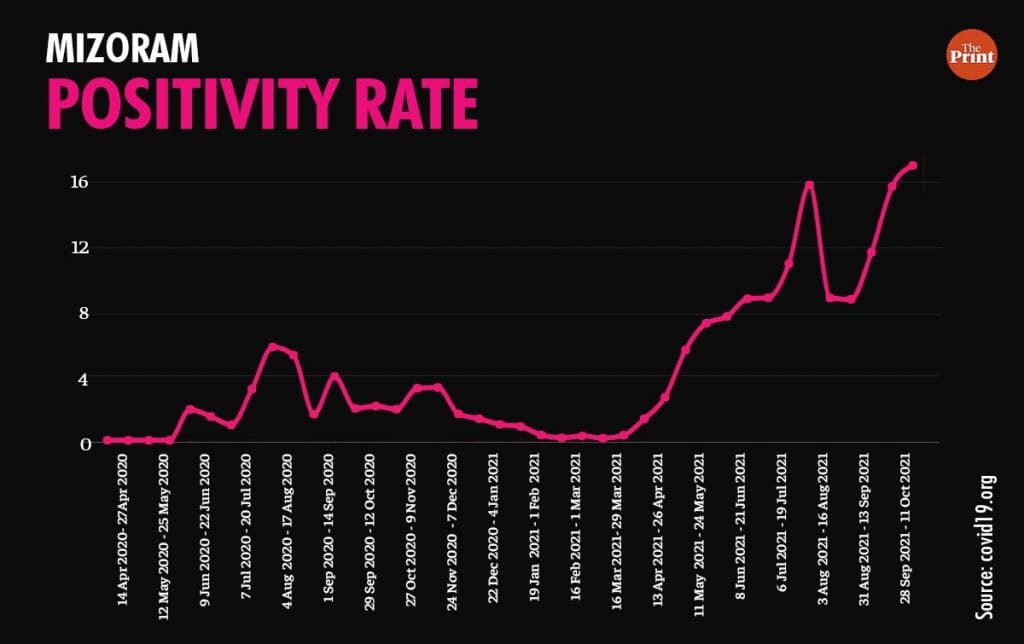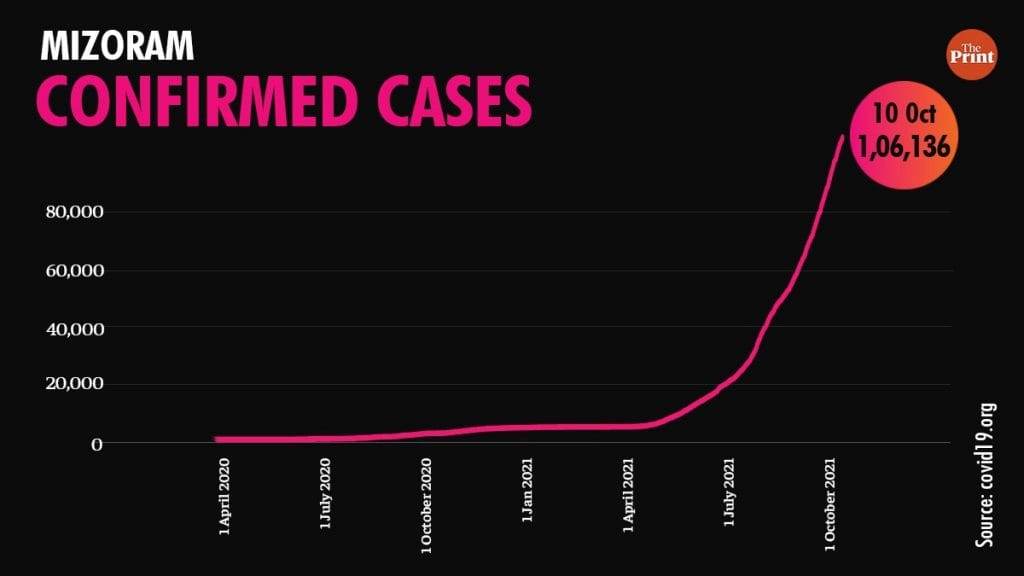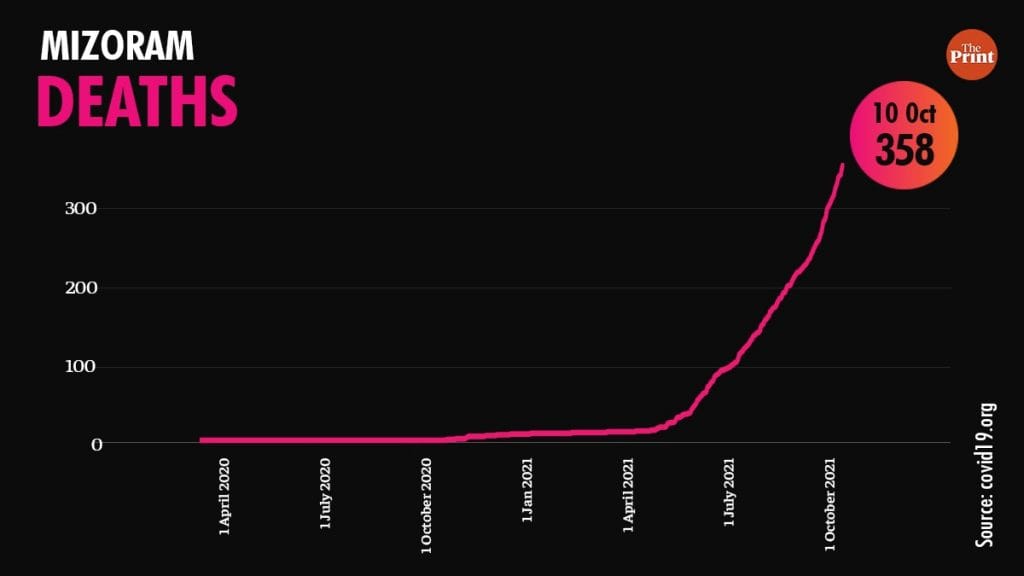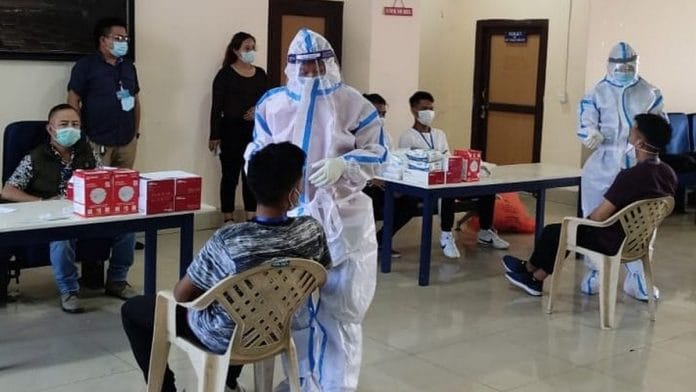New Delhi: In the last few weeks, as states around India saw a drastic decline in cases, the small hill state of Mizoram emerged as the country’s Covid hotspot.
According to ThePrint’s analysis, the state has seen a positivity rate of 17 per cent in the last two weeks, while the overall positivity rate in the country has remained between 1 and 2 per cent.

The positivity rate refers to the percentage of people who test positive for Covid of the total tests conducted, and serves as an indication of how well a state has been able to contain the infection.
Officials in Mizoram’s health department point to a variety of factors that could have led to the recent surge, including a large “vulnerable population” and “targeted testing”.
Also read: Mizoram villagers send 3 trucks full of vegetables for city folk battling Covid in Aizawl
Behind Mizoram’s ‘second wave’
According to data from Covid19.org as on 11 October, Mizoram has reported an average of 1,137 Covid cases over the last week, of which nearly 50 per cent cases are symptomatic. However, the case fatality rate — the proportion of deaths to the total number of cases — remains at 0.34 per cent.


Dr Pachuau Lalmalsawma, the state nodal officer of the Integrated Disease Surveillance Programme (IDSP), listed out several reasons that contributed to the surge:
• Presence of new variants — Delta, Delta plus, Eta, and other Delta sub-lineages
• Continuing community mini-transmission
• Aggressive search for cases through meticulous contact tracing
• Emergency testing of symptomatic patients and their family members.
Lalmalsawma added: “[It] looks like some compliance of Covid-appropriate behaviour by some sections of the community is below the desired level, which could contribute to the continuing surge, rendering the persons in their vicinity vulnerable.”
Dr Lily Chhakchhuak, head of the Reproductive and Child Health (RCH) division of the health department, echoed his words.
“We are a very close-knit society and always help each other in times of need… People will try to help each other despite everything; neighbours will want to come by and help. We probably haven’t been able to follow the movement. We are trying to make them understand that they can’t do this,” she said.
Dr F. Lallianhlira, principal director of the state health department, added that another factor that could have led to the surge is the prolonged lockdown in the state. Since last March, the Mizoram government continuously enforced curfews and restrictions that health officials say could have left a large section of the population vulnerable to the infection.
“Prolonged lockdown may be the reason. Delhi and other places were infected heavily before; many people died and many recovered. A lot of people were infected with the virus and have also taken the vaccine, and perhaps developed better immunity,” she said.
Data provided by the state’s health department shows that 32.86 per cent of the new cases are among children.
“In the first stages, we were one of the best states when it came to containing Covid. Now, because of the vaccine, those who are 18 and above are protected. But children are especially affected by this wave. We protected the children well in the first wave, but they have become vulnerable now,” Lallianhlira said.
Another health official who did not wish to be named said: “There’s a shortage of manpower. We are planning to mobilise certain teams from the Containment Management Unit for the seroprevalence exercise.”
Raising awareness
Last week, the central government rushed a four-member team of experts to Mizoram to review the situation. The team debriefed the state’s officials Tuesday.
Meanwhile, the state government has also launched a 10-day ‘All Mask’ campaign across districts to raise awareness regarding Covid-appropriate behaviour.
“We are working with UNICEF and have developed some Powerpoint presentations that can be utilised by teachers on Covid-appropriate behavior. We have incorporated these in the online classes,” Chhakchhuak said.
Lallianhlira, however, admitted: “This may not have immediate effect as the cases are now occurring at a community level.”
(Edited by Shreyas Sharma)
Also read: Talk of Covid booster shots not pertinent, studies show antibodies last a year: ICMR chief






